Basil variety "Green aromatic": cultivation from seeds, characteristics and description
Basil is a world-famous aromatic plant that is widely used in cooking and traditional medicine. It will not be difficult to grow it in the garden if you familiarize yourself with the nuances of cultivation in advance. Read about growing from the seeds of one of the best basil varieties - Green Aromatic.
The content of the article
Features of the variety
Green basil is an annual plant in the Lamiaceae family... It was first grown in the Middle East and Asia.
Reference. In Europe, this aromatic culture appeared in the 4th century and almost immediately became widespread.
Externally, the plant has the following features:
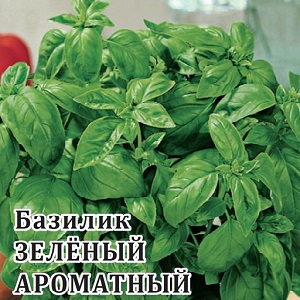 Stems are 4-sided, 30-60 cm in height, although wild varieties reach 70 cm.
Stems are 4-sided, 30-60 cm in height, although wild varieties reach 70 cm.- The leaves are oblong-ovoid, depending on the variety, they are colored green or deep purple.
- Stems, leaves and calyx are rough to the touch. They contain essential oils, which give the plant an unusual aroma.
- Flowering occurs in July - September.
All varieties of basil are similar to each other, but Green aromatic has its own characteristics.
Firstly, this crop is great for outdoor cultivation.
Secondly, the bushes quickly grow green mass, and the leaves are large in size and have a pronounced piquant aroma. The variety is actively used in cooking and canning.
Feature and Description
Basil is prized not only for its spicy taste and allspice aroma... The plant has medicinal properties.
The benefits of the spice are due to its rich chemical composition.:
- Greens contain vitamins C, PP, B2, carotene, ascorbic acid and phytoncides.
- The leaves contain an essential oil that strengthens the immune system and increases the body's resistance to viruses.
- Thanks to this chemical composition, basil soothes the nervous system, stimulates digestion and improves the absorption of nutrients.
Basil was originally grown in warm climates, so it is very demanding to the temperature regime. At the same time, it is planted both by seedlings and by direct sowing of seeds, but for the first time, young seedlings will have to be covered with a film.
The culture does not like excessive watering and marshy soils... If, in general, basil is resistant to diseases and pests, in conditions of high humidity, various rot and fungi attack it.
Application area
Green aromatic basil is grown especially for culinary purposes.... Its flowering does not represent any special decorative value, but the leaves are very large, delicate and fragrant. Due to this, they are actively used in cooking in fresh and dried types.
Reference. Basil of other varieties is grown not only as a spice. During the flowering period, the bushes are covered with panicles with small inflorescences, therefore the culture is considered decorative.
Advantages and disadvantages
Green aromatic basil - mid-season variety, therefore, no more than 50 days pass from the appearance of the first shoots to harvest.
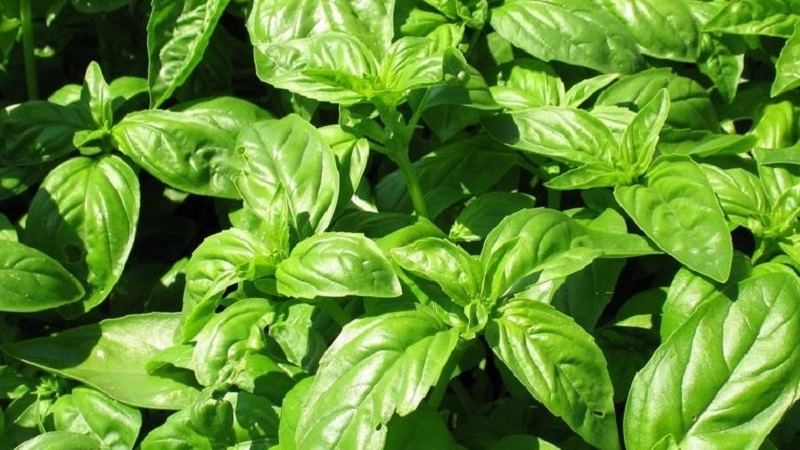
The advantages of this variety are considered:
- Unpretentiousness. With proper care, the bushes do not infect diseases and pests.
- Ease of growing. The variety is suitable both for open ground and for growing on a windowsill.
- High taste.Green aromatic basil leaves have a characteristic smell and pleasant taste, therefore this particular variety is most often used in cooking.
Disadvantages of the variety are minor... Basil does not tolerate excessive watering and swampy soils, so the site for its planting is selected especially carefully. You can get a rich harvest only on fertile soil with neutral acidity.
Growing technology
Basil is undeservedly considered a capricious culture. It was originally grown in the south, but under certain conditions the spice develops quite successfully in temperate climates... The main thing is to provide her with optimal conditions for growth and follow the planting rules.
Optimal conditions
In order for the green fragrant basil bushes to fully develop, they the following conditions are required:
- Optimum humidity. The culture does not tolerate swampy and waterlogged areas, therefore it is planted in places with deep groundwater or on elevations.
- Temperature conditions. The culture is considered thermophilic, therefore, in temperate climates, it is grown only in seedlings, and planting in open ground is carried out after the threat of recurrent frosts has passed.
- Light mode. For full development, basil needs intense lighting, so it is planted in open areas.
- The soil. It should be light and high in humus. On poor soils, the culture develops much worse.
It is better to grow basil by seedling method... It allows you to quickly get well-developed bushes.
This cultivation method has its own nuances.:
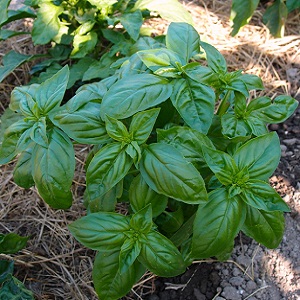 Seeds sown for seedlings late March or early April. They are embedded in the soil to a depth of 1 cm in a common container. The first 10 days the temperature is kept at + 25 ... + 27 ° C, after which the seedlings are seated in separate cups.
Seeds sown for seedlings late March or early April. They are embedded in the soil to a depth of 1 cm in a common container. The first 10 days the temperature is kept at + 25 ... + 27 ° C, after which the seedlings are seated in separate cups.- The seedling pots are grown and hardened in the greenhouse. Quenching is carried out about a week before the intended planting in open ground. To do this, watering the plants is limited, and the room is regularly ventilated to reduce the temperature.
- Landing in open ground is carried out in early June, when warm weather stabilizes. To ensure that the plants have enough space for growth and development, they are planted at a distance of 25 cm from each other. The space between the rows is 30 cm.
- Planting is carried out in small holes up to 8 cm deep. 1 liter of water is poured into each, and the plant is transferred to the ground directly with an earthen clod and sprinkled with soil so that young leaves and the central bud remain on the surface.
Further care
The success of growing basil depends not only on the correct planting, but also on the further care of the plant.
Note! Agricultural technology comes down to standard activities: watering, weeding, loosening and top dressing.
Each stage of care is carried out taking into account such recommendations:
- Watering... Young plants that have just begun to take root in the garden are watered daily, but in moderation. Fortified bushes do not need moisture so much. It is applied as the topsoil dries up. For irrigation, use warm (about + 25 ° C) settled water.
- Loosening and weeding... These procedures are carried out as needed. Weeds are removed regularly and the soil is loosened after each watering or heavy rain. This procedure breaks down the crust on the soil surface and stimulates the flow of moisture and nutrients to the roots.
- Top dressing... For active growth of green mass, basil is fed 1 time per month. The first feeding is carried out 2 weeks after planting the seedlings in open ground. For this purpose, use a solution of "Nitrofoski" (2 tablespoons per 12 liters of water). For 1 m² of the garden you will need 3-4 liters of ready-made solution. In the future, the same fertilizer is used, but about 3 weeks before harvesting, feeding is completely stopped.
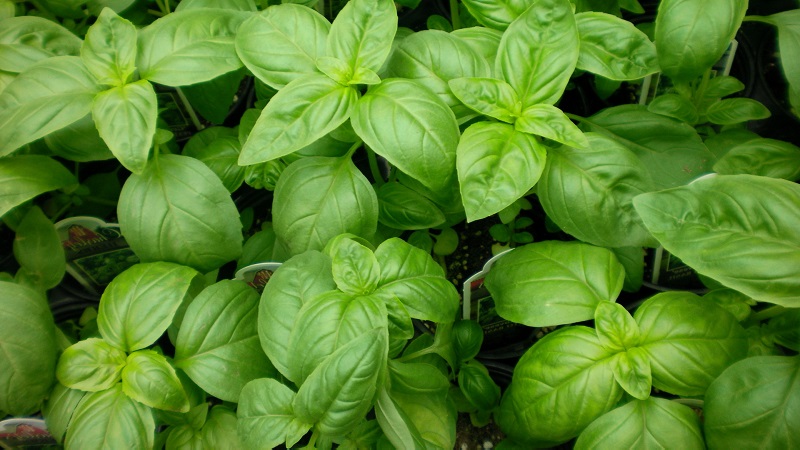
Possible problems, diseases, pests
It is not difficult to grow aromatic green basil, as this culture normally tolerates transplantation, is resistant to drought and pest attacks.
But, if the rules of agricultural technology were violated or the culture was originally planted in the wrong place, problems can still arise:
- Blue-red spots on the leaves. This indicates that the plants lack nutrients. To eliminate the problem, an extraordinary top dressing is carried out using complex mineral fertilizers.
- Leaves dry or curl. This problem arises when growing spices at home. The drying of the leaves indicates that the room is too hot and dry. To eliminate the problem, the pots are moved to a cooler place, ventilated and the watering schedule is revised. If the leaf plates are curled, then the plant suffers from a draft, and it needs to be rearranged.
- The basil began to bloom. This is a completely natural process, but it degrades the quality of the leaves that are used for food. To preserve them, the inflorescences are simply cut off.
Interesting on the site:
How to germinate basil seedlings in a snail correctly
Pests of green aromatic basil rarely strike because of its pronounced characteristic odor. Culture has immunity to disease, but if the bushes are improperly looked after, some diseases develop:
- Blackleg... Fungal pathology affecting seedlings. It occurs when too frequent and abundant watering. The stem of the affected plant becomes thin, soft and blackens. It is impossible to save such a seedling, so it is simply thrown away.
- Fusarium... Another fungal disease that occurs in conditions of high temperature and humidity. The stems of young plants become thin and brown, and the top dries out in adults. If you do not take action in time, the plant dies.
- Gray rot... Dry spots of light brown color are formed on the lower leaves. Gradually, they spread to the entire bush.
To combat gray rot and fusarium in the initial stages, use infusion of onion peel (1 part to 4 parts water). The remedy is insisted for a day, and then the plant is filtered and sprayed.
If the disease progresses, use the fungicide "Fitosporin". 1.5 g of the drug (powder) is diluted in 1 liter of water and sprayed with diseased bushes.
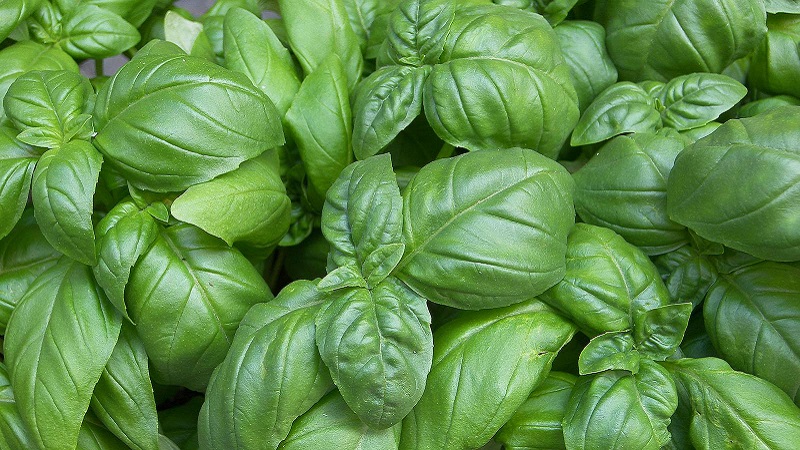
Features of growing seeds and seedlings
In regions with a temperate climate outdoors, green aromatic basil is grown only by seedlings... In the greenhouse and at home, direct sowing is practiced.
Reference. The advantage of the seedling method is that it allows you to quickly get developed bushes. But with direct seeding into the ground, it is easy to grow basil in a small greenhouse or on a windowsill.
Growing basil at home is the same as cultivating seedlings.... The seeds are first buried shallowly into the ground in a large container, and in the phase of 2 true leaves they dive into separate pots. In a greenhouse, they do almost the same. The only difference is that you have to leave free space in the garden, where the grown seedlings will grow in the future.
Reviews of summer residents
Real reviews of summer residents who have already grown the Green aromatic basil variety will help to fully appreciate the dignity of the culture.
Arina, Samara: “I read on the package that the variety is suitable for partial shade, and planted it in the cherry tree near the trunk. He ascended, developed normally and even bloomed, although in some special way I did not care for him. ".
Sergey Anatolyevich, Krasnodar: “I have been growing basil for many years, but I tried this variety recently on the advice of friends. I was pleased with the taste and smell, although outwardly I prefer varieties with purple leaves ".
Conclusion
Green aromatic basil is an unpretentious culture with high nutritional value. The plant is light and heat-loving, grows well on light fertile soils. If you know these features, it will not be difficult to grow it at home or in the country. Even gourmets will like the pleasant taste and aroma of this spicy plant.